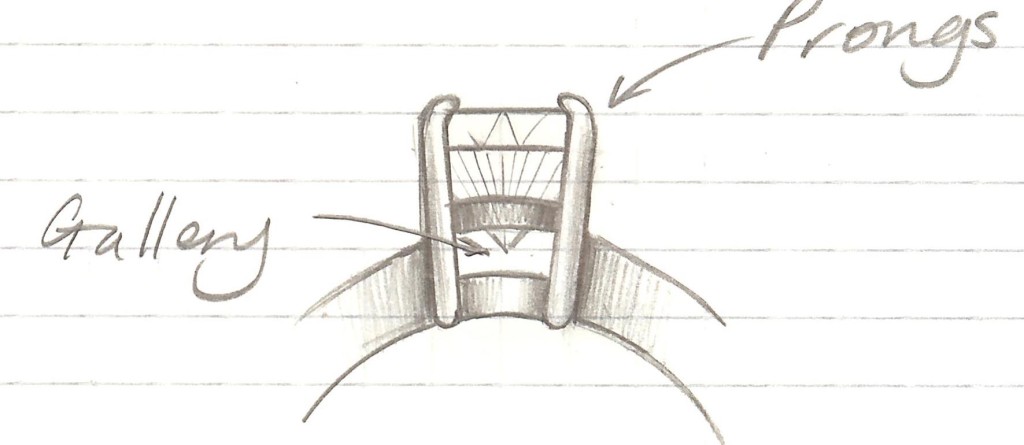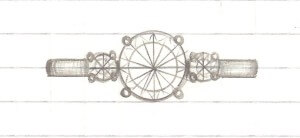Setting Styles
Choosing the right setting for your piece of bespoke jewellery may seem a bit daunting – there is so much choice and the setting style you go for can alter the look of the ring completely. Don’t let yourself get bamboozled, read on to understand the vocabulary of settings and to find the perfect one for your lifestyle and unique piece of bespoke jewellery.
The sketch above shows a traditional basket style setting which illustrates the basics of setting a stone perfectly. The prongs are the pieces of wire which connect the stone to the rest of the ring. The gallery is an opening in the setting which helps light to enter the stone for added sparkle.
Solitaire, Side-set or Trilogy?
The next thing to understand is the difference between a solitaire, side set and trilogy ring: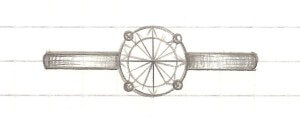
A solitaire is the classic choice – there is only one central stone which is the centre piece of the ring.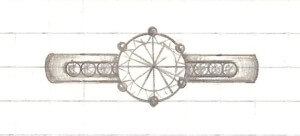
The side-set ring is the same as solitaire but with small stones set into the band. The illustration here shows four channel set stones either side of the central stone. You could have any number of side set stones and they can be set in any way you like.
The trilogy ring differs from a side set ring because the side stones are in raised settings like the central stone. The trilogy ring is a romantic choice as the three stones represent the past, present and future.
Thinking carefully about what type of setting you go for is a real opportunity to get creative with your design and make it stand out from the sea of mass produced jewellery. You can even hide personal features such as hidden gems or letters within a setting.
Settings which sit proud of the jewellery
Claw Settings
Claw settings are the classic choice and out of all the setting styles, provide the widest range of customisable elements. A major incentive to choose a claw setting is that they let in maximum light to the stone from every angle. However, a drawback to this design is 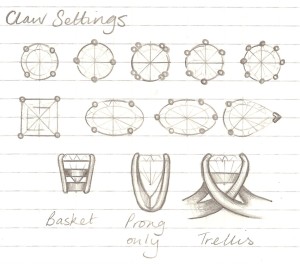 the potential for porosity in the prongs of a cast setting. Such fine wire could contain an air bubble which over time and through wear may mean a lost claw and possibly a lost stone. Claw settings should be checked over by a Goldsmith every so often to make sure they haven’t worn out or come loose.
the potential for porosity in the prongs of a cast setting. Such fine wire could contain an air bubble which over time and through wear may mean a lost claw and possibly a lost stone. Claw settings should be checked over by a Goldsmith every so often to make sure they haven’t worn out or come loose.
For Round Brilliant or Oval cut stones, you can choose 4, 6 or 8 claws to hold your gemstone. Four claws ‘square-off’ the circular shape and give a modern look, whereas six or eight claws appear softer, more rounded and traditional.
When setting a Square Princess cut stone in a claw setting, the claws wrap over the corners which are very thin and prone to chipping, thus protecting them from harm.
Pear cut stones can be claw set but I would recommend choosing one with an odd number – it is imperative with this cut to protect the pointed tip. The claw at the tip of the stone tends to be V-shaped to protect this delicate area.
A nice take on the claw setting is the ‘double’ claw, which gives a gorgeous vintage feel in four claw settings. These work well with Brilliant, Princess, Radiant, Asscher and Emerald cut stones.
Bezel or All Around Set
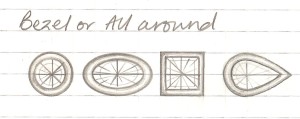 The all around setting is the opposite of the claw setting – it is a solid, continuous lip which outlines the whole edge of the stone. The sides of the bezel can be solid to give a low-key look, or windows can be cut into it to allow light in from the side and add extra design details. Some shapes of stones, such as the radiant cut, do not work well in this setting because not enough light gets in, but if you have a really firey diamond, this setting can work really well. It suits people who work with their hands because it is a very protective setting as it covers all the delicate edges of a gemstone. It gives a modern, streamlined effect to any piece of jewellery and works well with both facetted stones and domed cabochon cuts.
The all around setting is the opposite of the claw setting – it is a solid, continuous lip which outlines the whole edge of the stone. The sides of the bezel can be solid to give a low-key look, or windows can be cut into it to allow light in from the side and add extra design details. Some shapes of stones, such as the radiant cut, do not work well in this setting because not enough light gets in, but if you have a really firey diamond, this setting can work really well. It suits people who work with their hands because it is a very protective setting as it covers all the delicate edges of a gemstone. It gives a modern, streamlined effect to any piece of jewellery and works well with both facetted stones and domed cabochon cuts.
Side or End only set
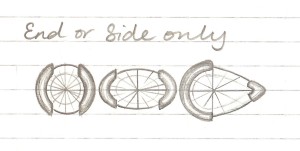 This setting is a modified bezel setting with the central part lowered or removed. From above, this setting style appears to cup the sides of stone. The major selling points of this setting style is that it allows more light to enter the stone than an all-around setting while protecting the majority of the delicate edges. It tends to trick the eye into elongating the shape of the stone, so for example, a round stone appears more oval with this style of setting. If you like the clean lines of tension set rings, this style of setting can give a similar look but with more protection for the stone.
This setting is a modified bezel setting with the central part lowered or removed. From above, this setting style appears to cup the sides of stone. The major selling points of this setting style is that it allows more light to enter the stone than an all-around setting while protecting the majority of the delicate edges. It tends to trick the eye into elongating the shape of the stone, so for example, a round stone appears more oval with this style of setting. If you like the clean lines of tension set rings, this style of setting can give a similar look but with more protection for the stone.
C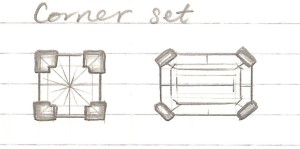 orner only setting
orner only setting
This style is a cross over between the claw setting and a bezel setting or like a end-only setting with the sides removed as well. It works well with geometric designs and highlights the angled corners of Emerald, Asscher or Radiant cuts. From the side, it looks like a chunkier claw setting.
Cluster setting
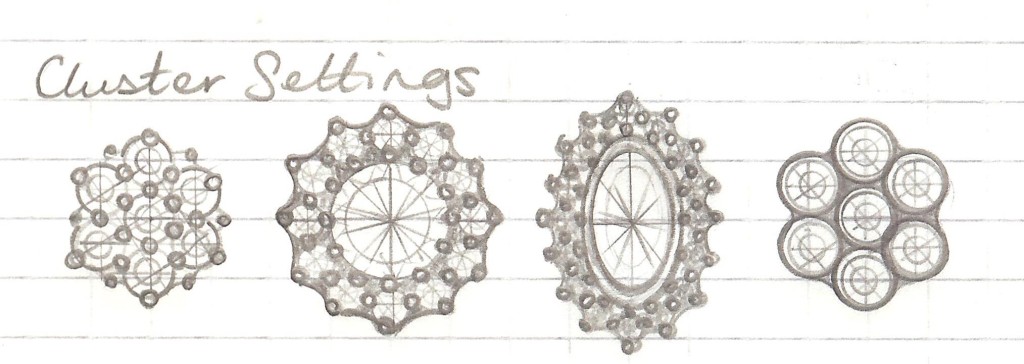 When you think of a cluster setting, we immediately think of Lady Diana and Kate Middleton’s sapphire and diamond ring. This is a beautifully feminine design with lots of design options. The centre stone tends to be set higher and from the side, you see a complex but regular claw pattern.
When you think of a cluster setting, we immediately think of Lady Diana and Kate Middleton’s sapphire and diamond ring. This is a beautifully feminine design with lots of design options. The centre stone tends to be set higher and from the side, you see a complex but regular claw pattern.
The first two sketches demonstrate traditional cluster settings with clawed prongs. The first shows a cluster setting with equal sized brilliant cut stones, whereas the second drawing shows the same design but with a larger central stone.
You can combine setting styles and stone shapes with the cluster setting, as in the third design with a bezel set oval cut stone in the centre which more streamlined as it has fewer claws, which potentially can get snagged on fabrics when worn.
The final sketch demonstrates a cluster style setting with equal sized stones all in individual bezel settings for a lower key look. The bezel setting makes the stones appear larger and provides no sharp edges or fussy prongs.
Halo or Open Tip setting
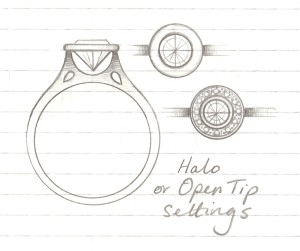 This style has really caught on in recent years – metal surrounds the edge of the stone like a halo and the shoulders of the band scoop under the stone, letting loads of light flood in under it and revealing the tip of the stone as a design feature. As demonstrated in this sketch, small windows can be cut into the shoulders of the band to give a lighter feel. You could also set a small stone under the centre gemstone for a hidden design feature visible in the side view.
This style has really caught on in recent years – metal surrounds the edge of the stone like a halo and the shoulders of the band scoop under the stone, letting loads of light flood in under it and revealing the tip of the stone as a design feature. As demonstrated in this sketch, small windows can be cut into the shoulders of the band to give a lighter feel. You could also set a small stone under the centre gemstone for a hidden design feature visible in the side view.
The halo can be increased in size to accommodate small stones being set in it for increased sparkle and a contemporary take on the cluster setting whilst retaining a timeless, vintage look. This sketch demonstrates the pavé style of setting around a bezel set centre stone.
A major benefit to this style of setting is that a flat wedding band will sit comfortably next to it because the setting is raised above the depth of the band.
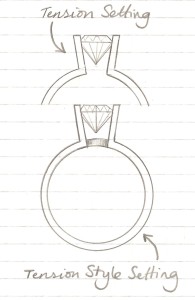 Tension style
Tension style
Tension set stones look incredibly modern and slick but the truth is that they are not very secure. Think about it – the stone is simply held in place through the tension in the metal, which can easily be knocked through normal wear and tear. This can be overcome with a hidden support under the stone which securely holds the two sides of the setting permanently together. It is only visible in the side view of the ring but gives some much needed strength to this contemporary style.
Stones set into the metal
If you want to design an eternity style ring or want to jazz up a pendant or earring design, you could consider setting stones directly into the metal so you have no raised setting. Any of these designs work well as stand alone setting styles or could provide a beautiful way to add shoulder detail to a ring.
With any of these designs, the goldsmith will drill a tiny hole through the ring behind the stone, which enables you to clean behind the stone and keep it sparkly.
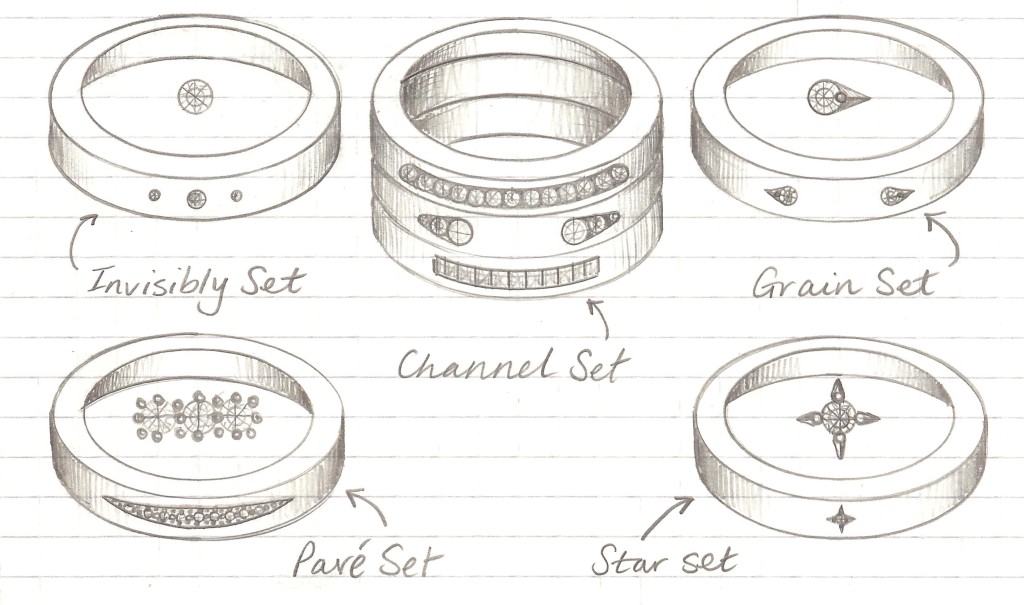
Invisibly set
If you’re looking either to set stones cleanly into the surface of a piece of jewellery or want a clean, contemporary look for any side stones in a ring, look no further than the invisible setting style. Stones are set cleanly into the surface with no fussy claws or bezels. They could be set in a row as shown in the sketch above or randomly across the piece of jewellery.
Channel set
The channel setting provides a wealth of scope for adding a line of stones. The Goldsmith indents a groove for the stones to sit in and closes the lip of the metal down to catch the edge of them and hold them securely. The stones butt up against each other for a clean, continuous line of colour or sparkle. This style works with round Brilliant cut stones or with square Princess cut stones. The square stones leave no gaps between each other which achieves a really clean, modern look.
You can obtain a graduated look with different sized stones in a tapered channel. This works well as a shoulder detail in a ring either side of a central stone.
Pavé set
Pavé settings give the ultimate vintage look. Stones are set similarly to the invisible setting but the Stone Setter scores lines into the metal to create a grain or tiny bead of metal which is used to trap the edge of the stone like a claw in a pronged setting. Multiple beads are created all over the set surface to give an all-over sparkly effect.
As with the channel setting, you can taper this effect for a feminine finish to the pavé set area.
Grain set
Grain settings are similar to the pavé setting style in that the Stone Setter engraves the metal to produce a small grain or bead which holds the stone in place. This is done in a small leaf or teardrop shape, making a stunning choice for a design inspired by natural forms. It works well as setting style for side stones on a stone set ring as the tapered shape leads the eye down the shoulders of the band.
Star set
The star style works in the same way as the grain setting but the lines radiate out from the stone in a North-East-South-West pattern, creating a star effect. This is a wonderful choice for side stones in a star inspired design, especially either side of a star sapphire. It also works well as part of a nautical inspired design because of the compass-like shape of the setting.

It is worth noting that most jewellers – even those who make your ring from scratch – use cast settings. The reason for this is that to make a setting is incredibly time consuming and a real art. However, if you really want something totally unique and are willing to pay for the Goldsmith’s time to create a truly one-off setting, then there is always the option when you have something made to your own specification.

